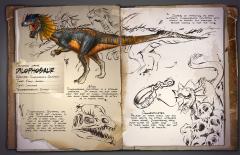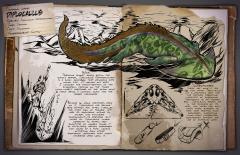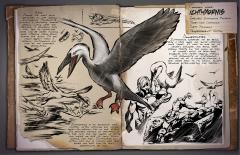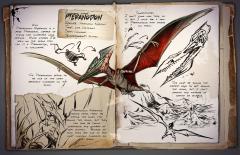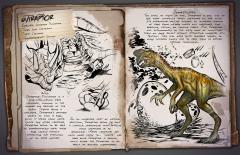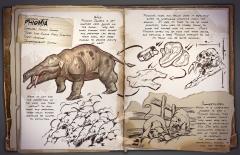Search the Community
Showing results for tags 'skittish'.
-

Babibasiliscus - The item collecting Speedboat of ARK
Actionskank posted a suggestion in Creature submission archive
Welcome to my reworked creature submission. (Original submission will be removed based on rule issues.) Note: This is mainly a place holder to guage the interest of the submission, with artwork and additional info being added depending on engagement. Babibasiliscus are the ancestors of today's Jesus Christ lizard thats adorned with it's large iconic headcrest. A creature that prefers life near sources of water where it can pick up smaller creatures and vegetation to eat in the safety of its own domain but at the first sign of danger, will rapidly run across bodies of water where predators will have a hard time chasing them down. Habitat: Wild Babibasiliscus are omnivorous and prefer quiet bodies of water with plenty of fish, small creatures and or vegetation and can be seen frequently going back and forth, collecting it's meal to eat in peace or feed it's mate. Taming: A tame which has different methods for both sexes. Males - You would first have to sneak up and find out it's craving food, once fed and the lizards trust has been gained it will follow you around and require you to kill and leave carcasses for it to eat, any large creatures, damage, or lack of things to eat will scare the creature away and lower taming affectiveness. Females - Generally found nesting and looking for mates, and are always looking for the flashiest of creatures to pair up with. As such, a collection of dyes will be needed to tame them. On a slow approach to a female they will raise their head to guage the survivors intentions and ask for a colour, on knowing the colour, you need to quickly paint a piece of your armor to that colour to appease her, extra taming affinity is determined by tech progression of your equipped gear (Cloth lowest, Tek highest. I.e. the Shinier the better!) Using the wrong colour, applying too late or being scared off will lower taming affinity. Tamed: The lizard is comfortable living in all biomes and has very little offensive capabilities but more than makes up for it with its speed and agility to get out of bad situations or in a pinch it relies on the player to pick off enemies from its back with a stabilized roller saddle that allows the player to look and attack from every angle whilst mounted. Abilities: (Although none are guaranteed it will make it to game.) Bi/Quadrupedal - Quad for brisk land cruising Bi for running from danger Radiation immune - Being found in the three main areas of Aberration the lizard has become adapted to the harsh conditions of the red zone without fear of radiation damage. (Can still be damaged being submerged in liquid element.) Water runner/swimmer - The lizards iconic feature, being able to run bipedal over water and liquid element at high speed, gaining a buff like spinos from water sources which can also be taken to land. It is also a decent swimmer thanks to its large paddle tail. Item collector - With its natural instinct of grabbing and relocating it's food to safer areas, the lizard is able to pick up single static items such as eggs, dead bodies, bags, dropped items, artifacts (Able to hold a second artifact.) and loot drops to different locations so a survivor can collect said items in much safer areas. Tic tac - An ability that allows the lizard to jump from one surface to another in order to reach places it normally couldn't. (I originally wanted a climbing creature but didn't want to overshadow the Rockdrakes so a parkour style wall to wall jump is what I ultimately decided on.) I hope you like the ideas in my submission although I understand that my vision for the creature may not be for everybody. I'm always open to critique and constructive criticism, so if you see something that you think would work better or better fitting, then please let me know in the comments. (Artwork will follow if this submission picks up enough interest.)- 1 reply
-
- radiation immune
- speedy
- (and 8 more)
-

Basilisk lizard - AKA The Jesus Christ lizard
Actionskank posted a suggestion in Creature Submissions
Welcome to my first ever submission and post! Note: This is mainly a place holder to guage the interest of the submission, with artwork and additional info being added depending on engagement. The Jesus Christ lizard, a very iconic reptile thats adorned with a large headcrest and fin-like sail across its back. A creature that prefers life near sources of water where it can pick up smaller creatures and vegetation to eat in the safety of its own domain but at the first sign of danger, will rapidly run across bodies of water where predators will have a hard time chasing them down. Habitat: Wild basilisks are omnivorous and prefer quiet bodies of water with plenty of fish, small creatures and or vegetation and can be seen frequently going back and forth, collecting it's meal to eat in peace or feed it's mate. Taming: A tame which has different methods for both sexes. With males, you would first have to sneak up and find out it's craving food, once fed it will follow you, as you kill and leave small carcasses for it to eat, any large creatures, damage, or lack of things to eat will scare the creature away and lower taming affectiveness. Females on the other hand are looking for mates and as such are always looking for the flashiest of creatures to pair up with. As such, a collection of dyes will be needed to tame them. On a slow approach to a female they will raise their head to guage your response and ask for a colour, on knowing the colour, you need to quickly paint a piece of your armor to that colour to appease her, extra taming affinity is determined by tech progression of your equipped gear (Cloth lowest, Tek highest. I.e. the Shinier the better!) Using the wrong colour, applying too late or being scared off will lower taming affinity. Tamed: The lizard is comfortable living in all biomes and has very little offensive capabilities but more than makes up for it with its speed and agility to get out of bad situations or relies on the player to pick off enemies from its back with a stabilized roller saddle that allows the player to look and attack from every angle whilst mounted. Abilities: (Although none are guaranteed it will make it to game.) Bi/Quadrupedal - Quad for brisk land cruising Bi for running from danger Radiation immune - Able to traverse the radiation zones without fear of hazard damage. (Can still be damaged by liquid element.) Water runner - The lizards iconic feature, being able to run bipedal over water and liquid element at high speed, gaining a buff like spinos from water sources which can also be taken to land. Item collector - With its natural instinct of grabbing and relocating it's food to safer areas, the lizard is able to pick up single static items such as eggs, dead bodies, bags, pearls, artifacts (Able to hold a second artifact.) and loot drops to different locations so a survivor can collect said items in much safer areas. Tic tac - An ability that allows the lizard to jump from one surface to another in order to reach places it normally couldn't but not climb. (I originally wanted a climbing creature but didn't want to overshadow the Rockdrakes so a parkour style double jump is what I ultimately decided on.) I hope you like the ideas in my submission although I understand that my vision for the creature may not be for everybody. I'm always open to critique and constructive criticism, so if you see something that you think would work better or might be better fitting, then please let me know in the comments. (Artwork will follow if this submission picks up enough interest.)- 1 reply
-
- radiation immune
- speedy
-
(and 7 more)
Tagged with:
-
From the album: Dossiers
Common Name: Pegomastax Species: Melanocetus Anglerprescum Time: Early Cretaceous-Holocene Diet: Carnivore Temperament: Aggressive to small fry, otherwise skittish! Wild: Whether it’s size is caused by adaptation to the island’s other inhabitants, or by cross-breeding with another larger species, Melanocetus Anglerprescum is the largest form of Anglerfish I’ve ever heard of. Typically found only among the deepest, darkest expanses of the ocean, this creature preys on smaller fish while being an excellent source of food for larger predators. Melanocetus has an array of bioluminescent light pods at the end of stalks on it’s head. Like typical Anglerfish, it primarily uses these to attract smaller fish and trick them into coming close enough for Melanocetus to consume it’s prey. This often makes wild Melanocetus itself relatively easy to spot among the briny depths. Domesticated: Exploring the depths of the ocean can be difficult. The cold, the lack of air, and the shocking absence of light combine to make travel very dangerous. A tamed Anglerfish can use the natural light at the end of it’s stalks to illuminate the depths, making exploration not only safer, but more lucrative. Furthermore, these luminescent nodules can be harvested to create long-lasting organic light emplacements for surface dwellings. -
From the album: Dossiers
Common Name: Dilophosaur Species: Dilophosaurus sputatrix Time: Early Jurassic Diet: Carnivore Temperament: Skittish Wild: Dilophosaurus sputatrix is a strange creature. It stands at just over half the size of known Dilophosaurs, and runs from aggressors as often as it fights them. Dilophosaurus sputatrix has a few traits not common in the Dilophosaurus genus. It has a very shrill call, and a decorative ridge of skin on its neck. I believe these are used to attract mates, as well as intimidate prey and would-be predators. Instead of attacking its prey outright, Dilophosaurus sputatrix spits venom to weaken and paralyze it before moving in for the kill. Domesticated: Because of their shrill cry and their ability to attack intruders from range, Dilophosaurus seem most suited as "guard dogs". Due to their small size, they are not suitable as mounts.-
- dilophosaur
- dilo
-
(and 8 more)
Tagged with:
-
From the album: Dossiers
Common Name: Diplocaulus Species: Diplocaulus Natatorinutrix Time: Permian Diet: Piscivore Temperament: Skittish Wild: Presiding almost solely within island's swamps, Diplocaulus Natatorinutrix is a small amphibian that primarily eats minor fish. It rounds out what I consider the middle-bottom of the ecosystem, feeding on the tinier non-insect creatures of the island while itself being a common snack for the larger carnivores. Because so many creatures prey on it, Diplocaulus has become very skittish and often flees at the first sign of trouble. It uses its amphibious nature to escape into whichever environment its predator isn't native to. Diplocaulus unique capability to retain vast quantities of oxygen allows to effectively remain submerged for hours at a time, usually outlasting even other amphibious creatures that might otherwise prey upon it. Domesticated: There are only a few uses for tamed Diplocaulus. It is primarily used for the (rather disgusting) practice of employing Diplocaulus as an oxygen bag. Diplocaulus stores air in the bladders of its head, and divers can suck from these bladders to take deep breaths while submerged, supporting long-term underwater exploration without the use of external gear.-
- diplocaulus
- water
-
(and 7 more)
Tagged with:
-
From the album: Dossiers
Common Name: Gallimimus Species: Gallimimus evolvelox Time: Late Cretaceous Period Diet: Herbivore Temperament: Skittish Wild: When someone asks me what the fastest creatures on the island are, Gallimimus is always a contender. Unlike the island's many armored animals, Gallimimus eschews strong defenses for the ability to outrun pretty much anything. A skittish herbivore, Gallimimus even looks nervous when eating in a peaceful clear meadow. Having no real way to harm predators, it simply runs away and uses its ability to stay safe. I've even seen wild Gallimimusoutrun speed-trained Utahraptors! Domesticated: There are two general camps on the use of tamed Gallimimus. One camp thinks that their inability to actually harm hostile creatures, and their inability to harvest most resources, makes them primarily a burden to the tribe. The other camp thinks that their extreme speed and ability to jump long distances is among the best for scouting and exploring... or just making a quick getaway!-
- gallimimus
- tameable
-
(and 5 more)
Tagged with:
-
From the album: Dossiers
Common Name: Ichthyornis Species: Ichthyornis piscoquus Time: Late Cretaceous Diet: Piscivore Temperament: Skittish Wild: Among the most vocal creatures on the island, Ichthyornis Piscoquus is actually a relatively normal seagull. Living near the beaches, it primarily eats fish, and its distinctive cries can be heard echoing over literally every beach across the island. As you might expect from a seagull, Ichthyornis will flee at the slightest provocation. Ichthyornis is an excellent fish hunter, often catching and killing small-to-medium fish in one attack. Its primary method of predation is to dive into the top layers of water and impale or bite its prey. When looking for fish,Ichthyornis will often just fly in circles over the water and wait for its next opportunity to dine. Domesticated: Ichthyornis surprised me by being a very loyal and social creature, once tamed. It likes to ride on its owner's shoulder, and bring that person treats (in the form of fish, of course) which its beak-grip enhances with extra healing vitamins. The personality of Ichthyornis reminds me of a housecat hauling a dead lizard back to its family, except bringing extra-healthy fish instead.-
- ichthyornis
- bird
- (and 7 more)
-
From the album: Dossiers
Common Name: Megaloceros Species: Megaloceros Latuscoronam Time: Pliocene Diet: Herbivore Temperament: Skittish Wild: Megaloceros Latuscoronam is a very skittish herbivore, found mostly in the forests and mountains of the island. Because of its large size, its fraught demeanor would be strange in any other place. But Megaloceros knows how fierce the predators of the island are, and knows that it is safer to flee from them than to risk its life in a fight. The horns of Megaloceros are very large, and make for an excellent source of Keratin. This, of course, makes it a valuable resource. Unfortunately, hunting Megaloceros is not easy because of their quick speed and ability to bound over most obstacles. Domesticated: Megaloceros is a jack-of-all-trades creature, and many who ride it value its versatility. It is decently powerful, and its resilience, speed, and ability to jump often come in handy. Finally, its charging horn attack tends to cause targets to "bleed", decreasing their health, stamina, and speed until healed!-
- megaloceros
- deer
- (and 9 more)
-
From the album: Dossiers
Common Name: Pteranodon Species: Pteranodon wyvernus Time: Late Cretaceous Diet: Carnivore Temperament: Skittish Wild: Pteranodon wyvernus is a large pterosaur, capable of flying for incredibly long periods. While others I've seen on the island still call it a Pterodactyl, this is inaccurate. The Pteranodon seems to be one of the least aberrant Reptile on the island. Pteranodon wyvernus mostly feeds itself by eating the small fish around the island, but they can also be found scavenging any number of dead animals. Because of this they are one of the most common Creatures on the island. Domesticated: I don't know how they did it, but I once saw a trio of Pteranodons with riders on them. This must be the fastest way to get around the island, but it can't provide any measure of safety or secrecy. -
From the album: Dossiers
Common Name: Oviraptor Species: Oviraptor Philodator Time: Late Cretaceous Diet: Carnivore Temperament: Skittish Wild: Oviraptor philodator is a small-to-medium sized carnivore, common in the jungles and beaches of the island. Despite being a carnivore, Oviraptor’s primary source of food is eggs, which it steals from nests. Unlike any other creature, Oviraptor seems to be able to surreptitiously steal these eggs usually without attracting the attention of an irate mother. In an incredible feat of natural selection, Oviraptor seems to emit a chemical pheromone that affects many creatures as an aphrodisiac. Mated creatures are much more likely to… “create” new eggs while Oviraptor is around, which allows the Oviraptor to go about its business unperturbed. Domesticated: Too small to fight or ride, Oviraptor is still one of the more commonly tamed creatures on the island. Its pheromone release ensures an increased stream of eggs from nearby mated wild creatures, for breeding, eating, or cooking kibble. And Oviraptor will autonomously do the dirty work of collecting them on your behalf without attracting unwanted attention. They also make quite adorable sounds, so many children simply like to keep them as rather strange companions. -
From the album: Dossiers
Common Name: Parasaur Species: Parasaurolophus amphibio Time: Late Cretaceous Diet: Herbivore Temperament: Skittish Wild: Parasaurolophus amphibio has some of the more interesting adaptions of all creatures I've seen on the Island. Like all parasaur it has a signature head ridge. Very docile at first, I've often been able to approach them without complaint. If startled, however, the Parasaur immediately runs - very far and very fast. This species of Parasaur seems to have a previously "disproved" use for its ridge. Small openings at the top of the ridge allow it to be used as a snorkel. This is unique to Parasaurolophus amphibio, as is their surprising speed in the water. Domesticated: As a relatively simple creature to domesticate, Parasaurolophus amphibio is one of the most common mounts I've yet seen on the island. Its ability to run fairly fast for lengthy intervals makes it a solid mode of medium-range transportation, though it has almost no ability to defend itself or its rider.-
- parasaurolophus
- parasaur
-
(and 6 more)
Tagged with:
-
From the album: Dossiers
Common Name: Phiomia Species: Phiomia ignavus Time: Late Eocene/Early Oligocene Diet: Herbivore Temperament: Skittish Wild: Phiomia ignavus is another herd animal on the island. They are small enough that almost any predator can bring them down, but large enough to provide plenty of meat. Were it not for the protection of the herd, and their instinct to run from any predator, these would almost certainly be hunted to extinction. A Phiomia's tusks and trunk make it especially suited to scavenging plant life from the ground. It uses its tusks to dig up loose plant life, then uses its stubby trunk to scoop the foliage into its mouth. Adult Phiomia often dig up food for their young, and watching a baby Phiomia attempt to use its trunk can be quite amusing. Domesticated: While it is completely possible to ride a Phiomia around, they are a meager choice. They work very well, however, as pack-mules. And I've seen some communities keeping a herd of these around as livestock. The Phiomiarequire protection though, as they are terrible fighters.

